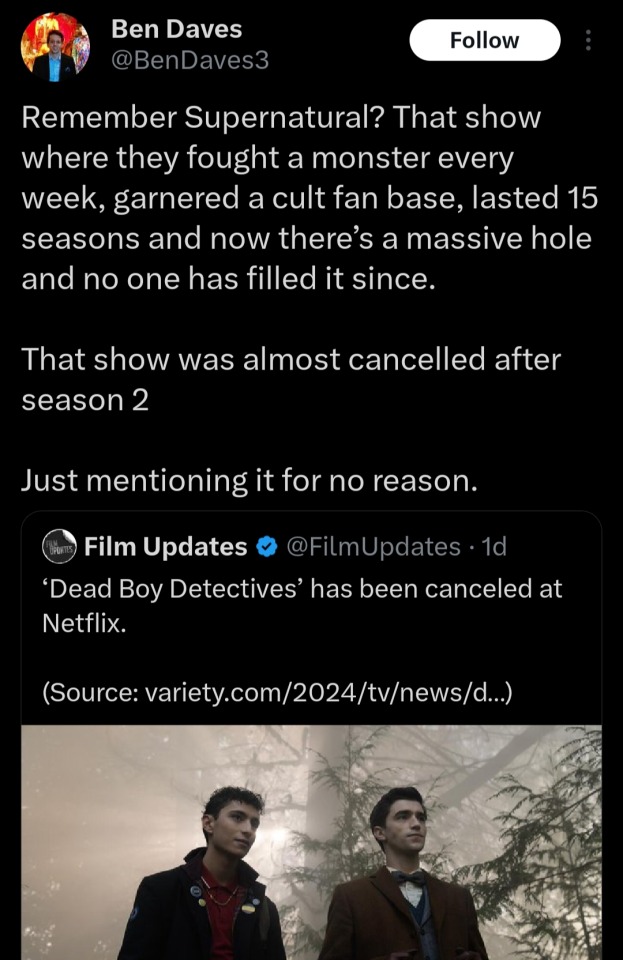#2014*15 Season
Explore tagged Tumblr posts
Text
December the 6th: Bayern-Bayer Leverkusen (1-0)



#what can I say#this is so iconic#this is so pure#and their smiles is everything#what has always fascinated me is that this is so unrequited#it's not a celebration after a goal#not a celebration after a big victory#and to be honest neither of them played particularly well during that game#ah I miss them so much#thomas müller#robert lewandowski#müllendowski#müllendowski anthology#fc bayern#season 2014/15#remember me but forget my fate
65 notes
·
View notes
Text


#dc#gotham#tv#dc comics#ed nygma#the riddler#oswald cobblepot#the penguin#nygmobblepot#riddlebird#oswald x edward#i made this#memes#funny#funny memes#gotham fox#gotham 2014#gotham season 3#season 3 episode 15#3x15#s3 e15#batman rouges gallery#my memes#my edit#rogues gallery#gotham rogues#season 3 episode 4
90 notes
·
View notes
Text
michi 🥹🎀🩵
#michael hayboeck#ski jumping#my man my man my man#i love him so much#145 f*cking meter#are we back in season 2014/15#michi hayböck vierschanzentournee sieger???
7 notes
·
View notes
Text
.
#prefacing this w ik in fanfiction they're all just our little barbie dolls we're making kiss and it doesnt matter whatsoever but like Do you#understand how much love and respect and loyalty there is between connor and leon irl#like in connors nhlpa ama he immediately no question said that leon's the nhler who knows him best + that he's spent his entire professiona#career w him. whenever leon's asked what he thinks of connor the first sentance out his mouth is 'you [the media] know. he knows' and then#he carries on talking about how he's the best player in the world + connor never hesitates to return the sentiment#and between the two of them it's not sentiments they sau it like its fact bc it is#and their whole 'cup or bust' thing every analyst and their mother have taken it as a 'they're going to win in edmonton or not at all' in t#e sense that they want to stay in edmonton n stay together <- like not even in an insane person edmonton polycule type of way in the they'r#the best players in the world and have insane chemistry on the ice and are eachother's best friends type of way#like a reason why their pp is so lethal is bc those two on a line + the other team down yeah ofc thats going to be automatic#and leon saying that their best beats anyone else's best no doubt and connor talking about building the team from the ground up like leon w#s there when they got boo'd off the ice in 2014 he was a part of building the team that's thier damn team and in turn the sheer amount of#respect the rest of the team have for them and they have for the rest of the team and the trust that while they're the best players they#don't have to play for all of them n that's part of thier whole like. our fourth line stands up to any other first line rock solid belief#like and ofc thier on ice hugs and lockerroom hugs and that moment in the sportsnet knee injury doc and how they mention that they're best#friends whenever theyre asked and how their gf's are also best friends and also their damn dogs#NOT TO MENTION. he's my ride or die. im really lucky our paths crossed here in edmonton. as a friend it was really tough to watch that#<- leon's insane 2022 playoff run on a broken ankle#and the way leon's been dubbed the german gretzky and connor's been the next next one since he was 15 and the way they have such a solid#control of the lockerroom together and i dont know if they've ever said conflicting things to the media and how they've said that they push#eachother to be better (connor saying that leon told him to score more)#and their little taps throughout their season and bringing back their team from the dead and leon being the one to make connor laugh in#pressers and on the bench#ALL TO SAY. like i am a mc.matt.drai enjoyer in the threesome/winners room/asg/2997 are actually quite abnormal about eachother and matthew#has never been normal about anything in his life and this might be fun. kinda way#but 2997 are soulbonded in ways quite possibly none of us will ever be able to truly understand#<- also i do mean this genuinely like they're not normal people but both of them are not normal#SORRY FOR RAMBLING. i just wish there was better written fanfiction.#<- wish to be the change you see in the world innit tho#so funny to me how the eh is just canadian innit.
12 notes
·
View notes
Text

This episode gave me a mild panic attack and I am not kidding… I literally almost threw up. I was feeling WAY too many things.
I love this show. When it aired I was 15, and I never watched past like the third episode… and now that it’s almost been a decade I decided I needed some Tom Cavanagh in my life and by golly did I GET Tom Cavanagh.
I also got all these characters (minus Iris whom I dislike with a burning passion) that I LOVE. And then my MANS had to go and kill my BOY 😭
#the flash#the flash 2014#season one#episode 15#eobard thawne#harrison wells#cisco ramon#caitlin snow#barry allen#tom cavanagh#grant gustin#my boyyyy#my man <3#aghhhhh
13 notes
·
View notes
Text
Gotham AU where everything is the same but Lana Del Rey is in it 💋🖤
Inspired by @x-marge 's post "if gotham city was real lana del rey could stop writing about new york"
Disclaimer: AU Lana possibly romanticizes bad stuff a bit more than in her actual songs (I'm no expert on her, I just like her music, but Gotham can make people a bit crazy, so I think it fits)
•Valerie Vale trades info with her for eXpoSitioN but it actually pays out...until Valerie starts to hate the romantic portrayal of things to do with crime
•seriously, I'm talking love-interests inspired by Carmine Falcone, Sal Maroni, the Ogre (Jason Lennon) & later Oswald Cobblepot & the Riddler 🥰, think lines like "If he's a serial killer then what's the worst that can happen to a girl who's already hurt?" from Happiness Is a Butterfly
•Lana would absolutely date Harvey Bullock at one point. Yep, the police songs are about him 😚
•Jim hates her (or is this just me wanting him to have one non-romantic relationship with a younger woman? 😐🤔) and it isn't at all because she makes relationships with mob bosses sound tempting when he knows he should never give in 🤭🥲
•Meanwhile law-abiding people who are intrigued by crime like Kristen Kringle & Lee Thompkins feel seen. In a city as horrible as Gotham it's not at all crazy to fantasize about control by attraction/love in a dangerous situation
•The dangerous thing is the people who take er more problematic love-interests as an example (for example 🎵"Do you think you'll kill for me one day?" "Yes, of course I will, my darling."🎵). Looking at you, Riddler 👀
Spoilers for S03 E15:
•'National Anthem' is inspired by mayor Cobblepot "going missing". Ed wants to sue her so badly but knows that the lyrics aren't indicative enough of inspiration
•Fittingly enough, hallucination!Oswald sings one of her songs. Maybe National Anthem or something like 'Summertime Sadness' 😭
•Meanwhile the Riddler gets frustrated because he's gaining the wrong attention, he didn't ask to be called The Chess Killer or get incorporated in love songs!
If liked this and think "This crossover is probably a one-time occurence on it-happend-once-in-a-meme", you might like my photo edits of Barbara Kean & Nygmobblepot as Lana Del Rey covers 🤗😂
#lana del rey#gotham#gotham tv#gotham 2014#gotham fox#gotham x lana del rey#gotham au#oswald cobblepot#edward nygma#jim gordon#harvey bullock#lee thompkins#kristen kringle#carmine falcone#sal maroni#gotham humour#nygmobblepot#hallucination!Oswald#gotham season 3 episode 15#harvey bullock x lana del rey#gobblepot#gotham harvey bullock#lana del rey songs#lana del rey love-interests#lana del rey lyrics#lana del rey au#gordlock
4 notes
·
View notes
Text

I can't stand the tension! I miss Unicorn: Warriors Eternal so much! I just need to know if it's coming back or not! If it's getting another season (or three like Genndy hoped for), then that's freaking awesome! If it's getting Zaslav'd before it can ever address that cliffhanger, then that's the biggest disgrace to happen in this industry in about a month or two (maybe idk). But just let ne know already! It's been a year! I miss Mel/Em, Ed, and the others so much! SGGYJGDGHBFGRKKDDYHHH
#unicorn#unicorn warriors eternal#guess being away from new cartoons between su's ending and unicorn's run made me rusty on handling long hiatuses#but even so with steven we at least knew the show would still be here it was a matter of when not if#(ftr i was only watching that show in 2014-15; a tiny bit of '16; and from single pale rose onward so i missed some infamous hiatuses)#even during that 8-month hiatus where we weren't sure if there'd be any more show we at least knew of the movie#unicorn is nothing like that#yeah it's the passion project of genndy (still pretty secure at wbd) and it was actually a solid ratings success#but you never know with the horrors of the zaslav regime#if infinity train couldn't even get the dignity of staying on streaming then truly nothing is safe#i also have no clue if ivandoe is getting season 2...#but to be fair it's getting so many freaking hiatuses in the us for some reason that i at least have quite a bit of time left with it ig#man i miss the days when it didn't feel like every cartoon had at least a 50% chance of getting blown up by rancid executives#like don't even get me started on how disney channel/xd always has 1-2 banger cartoons on that can never make it past season 3#(i mean i've been too lazy to actually watch amphibia or owl house or ducktales...#...but everyone loves them so maybe i should get off my butt and watch them at some point in my hopefully lengthy existence)#cartoons#post started as a fan of an obscure show on hiatus going crazy and ended up as a rant on the concerning state of animation. go figure.
3 notes
·
View notes
Text
holy shit I really miss Denmark.....
#it's getting closer to the time of year i used to go on vacation there... i always get nostalgic around this time#IT'S BEEN 9 YEARS SINCE I'VE BEEN THERE LAST AND I MISS IT SO SO SO MUUUUUCH 😭#the last vacation in 2014 was also the one i got the 1st season of hannibal on dvd at the grocery store for under 15 bucks#and watched the first 4 episodes with a friend while all cozy and cuddled up in a big armchair infront of the oven...#AUGH I MISS IT SO I WANNA GO BAAAACK#but vacation homes are expensive and i dont have the means to even go there on my own or get around town...#maybe one day when i have a driver's license and a car
3 notes
·
View notes
Text
January 16th 2015: Handball Men's World Cup, Germany-Poland (29-26)


#the look of someone who knows that he will be able to tease his teammate about that game for days#and the look of said teammate who knows is going to be teased about that game for days#fc bayern#thomas müller#robert lewandowski#müllendowski#müllendowski anthology#season 2014/15
20 notes
·
View notes
Text
Major spoilers for S03 E15!
Oswald: Vengeance hath come for me, but I am nothing but a broken heart. 💔🎭
Edward: Ugh! Can you please just be struck with fear? 🙄
I think their view differs because of how much Ed still cares about Oswald:
Oswald point of view: his father's ghost (Oswald already believed in ghosts), Ed making dramatic speeches (nothing new to him) about betrayal, love & revenge (Oswald knew he deserved some revenge)
Ed's point of view: 😢💔😭💧🐟🌱👻







Basically: Oswald being sad.
More concretely: Ed choking Oswald (like Ed did Kristen), seeing Oswald despite him being dead (like Ed did Kristen, then Isabella, who he saw Kristen in)
->Ed: Oh, dear, this was horrifying. Oswald must be miserable.
->Oswald: Well, I know horrifying. 🤷♂️
Shout-out to me, for making screenshots of Oswald being sad or a ghost 😔👏
no because Oswald sees his fallout between himself and Edward as a classic stage tragedy designed as punishment for his sins. Edward sees it as a psychological horror designed as punishment for his sins. Do you see it. Do you get the difference here.
#nygmobblepot#gotham#gotham tv#gotham 2014#gotham meta#edward nygma#oswald cobblepot#gotham analysis#gotham season 3 episode 14#gotham incorrect quotes#edward nygma incorrect quotes#gotham season 3 episode 15#gotham season 3 spoilers#oswald cobblepot incorrect quotes
94 notes
·
View notes
Text
If you follow me, most of you know Ibrahim @wolf-aid ! He's amazing and had been through so much unimaginable pain this past year in gaza. Yet he remains persistent and so kind.
Recently, he made a post to help raise money for a hospice providing food to displaced Palestinians, and it's done very well! People have been sharing and donating gladly, which is incredible, and we thank you all for doing so from the bottom of our hearts. However, Ibrahim has been raising money for his own family independently of that campaign and donations have been rather slow lately!
Ibrahim is a little brother to me, i love him dearly and i can't stop thinking about how much he is going through this holiday season. As you celebrate christmas, hanukkah, and new year's, please consider sending a bit of money my brother's way. Your support makes him very very happy and gives him much needed hope for the future.
€36,592 raised of €50,000
thank you so much!!!
3K notes
·
View notes
Text

girliepop.
#leon draisaitl#this was last season and his career high in pims by over 20 ?#close enouygh welcome back brady tkachuk i suppose#connor's lifetime high in pims was with the erie otters in 2014-15 (48) and his nhl high was 45 in 21-22 if u were wondering
6 notes
·
View notes
Text
#based on premiere date of each season#supernatural#spn#dean winchester#sam winchester#castiel#poll#tumblr polls#polls#i’m sure this has been done before#but I wanted to group the seasons my own way so
422 notes
·
View notes
Text
Practice

Notes: I don’t care what anyone says, werewolves have a mating season or something. I was on 2014 Wattpad when mating season fanfics were a thing, just let me have this.
Scott McCall needs to practice some self-control.
Kinktober Masterlist
༻༺༻༺༻༺༻༺༻༺༻༺༻༺༻༺༻༺༻༺༻༺༻
Scott McCall, is a beast. You can’t convince me otherwise, he literally is. He’s a animal on the field, when it comes down to it he got so good by practicing. Hours and hours of painstaking practice hindered by his asthma but now he was undoubtedly great. With his enhanced physicality plus the gift all that practice got him captain of the lacrosse team. Practice was discipline, which Scott tries to instill in himself along with him pack members.
Discipline and practice led Scott to be a diplomat who always tried to see the best in others and try to find the best way to lead his friends and anyone else he promised to protect to the best path possible. He practiced anything he needed to excel in. He practiced controlling his urges as a werewolf. Practice in making the hard choices he has to make as a leader, practice in balancing his life. Yes, practice was the defining factor in Scott’s life.
So when Scott met you and knew that he wanted, no, needed to be with you for the rest of his days he practiced. He knew what that meant. He wanted to be with you no matter what, and one day have a bunch of kids with you (when he ‘jokingly’ said five, you laughed so hard you choked) had to practice being a man. Not a ‘man’ in the sense that he was big and mature. No, he had to practice being the man you needed.
He had to practice adjusting to your culture, your needs, your view on life as a black woman. And once he did, the good times rolled and haven't stopped since then. Lately, with a new Spring though Scott felt as if he needed more practice. Or more discipline. He wasn’t sure which.
Everyday he was horny. Every night he was horny. Every afternoon he was horny. It was like how some people get allergies, Scott was afflicted daily. Instead of swollen eyes he had a swollen dick and nothing was helping. Meditating, tea, trying to focus, having sex with you. Nothing.
Eventually it got to the point when you had to tell him you needed a break. It was constant. Constant creampies, orgasms, hair pulling, kisses, words of affirmation and aggression, and you needed a break. So, you booked yourself a spa treatment to escape Scott’s urge to hammer his hips into yours as hard as possible and left him to himself for the day. All his practice was failing him at the moment. He couldn’t force himself relax, to not open any photos of you and immediately jerk off like it wasn’t 8:15 in the morning. He hadn’t even had breakfast. What happened was, he woke up to you giving him a kiss goodbye. He got a whiff of your perfume as you floated through your bedroom door then once he heard your apartment door close.
What was his favorite little trick to stop himself from giving into his base urges? A trip down memory lane of course.
More specifically the time you too had sex and he came so hard that you almost got turned into a werewolf on accident. And when he realised he may have been so persistent because he wanted to fuck you because he was amazing filling you and your apartment with kids. With little boys and girls (perhaps three or four) running around. Maybe a boy with his hair and your eyes? A girl who was the perfect combination of the two of you together? Maybe twins, a boy who took after you and a girl who took after him? Either way, Scott fucked you like he was about to make it happen.
He fucked you with such intensity that morning that you were out of commission for the rest of the day. The room was a dark red color from the small special lights you two bought for your bedroom when you first moved, and he didn't know red could make someone look so good. The sweat shimmering on your skin, the creamy ring you left around the base of his dick, while he growled over you. His eyes ran over your skin, admiring the myriads of hickeys he had bitten into your skin.
You were like a work of art that Scott was blessed to admire for the rest of his days. He slammed himself into you that night, while you squealed and shook from the pleasure. Your dark brown beauties rolling back would be concerning to Scott in any other situation but in that moment it was all he wanted. He wanted to see you spazz out and droll over him. He wanted your eyes to roll back, he needed to see you moan with clarity from feeling him cum inside of you.
When he slipped out, he decided that night he could give you a slight break, and was in your face roughly kissing you. You were perfect, so as he leaned down and closer to you his hand found his dick. He hissed, from the warmth of your hand and feeling his dick stimulated from the gorgeous woman giving him a hand job. You were both breathing heavily while sloppily making out but Scott couldn’t let you do better handy work than him. What type of man would he be?
Taking two fingers, determined to get you ready to go again, Scott used all the practice he’d gained over the years and his knowledge of how girls worked, pressed two fingers against your wet clit. You were slick, and very hot down there. In truth, he would’ve gone for your tits, warm and soft like two large pillows but he’d had to stop kissing you for that. He settled for rubbing two fingers up and down your pussy, hearing you whimper. Relishing in every shudder of your body, how you whimpered in his ear.
Two fingers slipped inside of you, and he was fighting back the urge to push you on your back and bite you until you were crying from joy. But Scott has to remember there is such thing as too rough, something he learned after what he refers too as the ‘incident’ and you call ‘the almost trip to the emergency room’ either way he learned that lesson. So with practice he made sure he never hurt you that way again in such an intimate moment.
You moaned into his kiss, and he remembered to give you a softer kiss. Something just a little bit softer while he passionately thrusted his fingers inside of you. You were giving him a handjob so good he was about to drop to his knees and give you his entire life. After a moment, he slipped back into you, his grip on your hair returning.
Your mascara was running down your face, while he tried easing back into the thrusts. He didn’t want to immediately overwhelm you. You moaned and that was his sign, to pick up the pace. He was about to cum inside of you and act on that little urge of his. You liked creampies anyways. Thats an understatement, you loved creampies. Now you were staring into his eyes, moaning nonsense to him.
Telling him you were his, bad move. Now there was no chance for him to have the good sense to pull out of your pussy. Well according to you, his pussy but he wasn’t picky (those words made his head spin). When you moaned out for him to cum in you, what was he supposed to do? ‘Oh no thanks sorry babe!’ he did what any man so lucky to see you this way would do: he doubled down. Holding you in place his eyes flashed down at you and his whole body trembled. His stomach clenched and he sunk his teeth into the crevice of your neck, leaving a dark bruise to form there.
One more thrust as you creamed all over him, arching your back while you moaned nonsense about how much you adored him and ‘thank yous’ while he rolled his hips into you. He saw it so clearly. He saw you, pregnant and planting a soft kiss onto his forehead while you sat with a toddler next to you.
Recalling this event was supposed to help Scott trick himself into calming down. Still he couldn’t stop himself. In the past, Scott was able to calm himself by recalling all the past times and telling himself not to be greedy because you two had incredible sex all the time.
But what the hell? Everyone has lapses in discipline, and some practice never hurt anything. Shrugging out of his pajama pants, he grabbed the led remote close by flicked on those red lights you were under a few nights ago.
#black reader#x black reader#x reader#fem reader#multifandom account#requests open#kinktober 2024#teen wolf scott#teen wolf smut#teen wolf#scott mccall x black reader#scott mccall x reader#scott mccall smut
273 notes
·
View notes
Text
Hi @netflix and @warnerbrostv! I'd like to talk about the show Supernatural and how its history and legacy can provide some insight on why you should reconsider your decision to end Dead Boy Detectives after one singular season.
Supernatural is undoubtedly one of the most successful television fantasy franchises, but many don't know that it was nearly cancelled after season 2. Thankfully (and luckily) for the network they didn't go through with cancelling the show and by season 4 it was regularly breaking viewership records. A show that was nearly cut short in its prime - much like Dead Boy Detectives - became one of the largest and most recognizable fandoms across social media platforms between the years of 2010 and 2014. The show was so wildly popular that a confession scene between two of its leading characters (Dean and Cas) is STILL used today in a meme format to circulate everything from fandom news to world politics and current events. You can't go to a single comic-con without running into something relating to Supernatural, and ever since its conclusion there has been an opening in the market for a show to take its place.
I can say with absolute certainty that, given the proper time to flourish, Dead Boy Detectives would be the show to fill the spot Supernatural has left behind. It has loads of charm alongside a sensational balance of action, whimsy, heartwrenching character development, and horror. Furthermore it is objectively better with representation than Supernatural was, which is always something embraced in fandom spaces (which are diverse and filled to the brim with queer, neurodivergent, and/or a wide range of people of color).
I also think it's fair to remind you that one of your most popular "Nerd" shows, Stranger Things, is coming to an end after a 10-year-run, leaving behind yet another gap to fill, but this time on your very own platform.
It isn't too late to reconsider the cancellation of Dead Boy Detectives. The fanbase is dedicated and hungry for more, and we know you are currently sitting on finished season 2 scripts, making it impossible for the writers to take this story anywhere else for quite some time. The scripts are there, the cast, crew, and writers love what they do and want to make more... there's simply no reason to not give Dead Boy Detectives the chance it deserves - this time with an entire fandom that wants nothing more than to consume this show, market the hell out of it, and buy merch relating to it (another win for you).

(Source x)
Oh and did I mention that Steve Yockey was a co-producer on Supernatural as well? You know, that wildly popular show I just told you about that lasted 15 seasons. You are sitting on a golden goose; Steve Yockey and Beth Schwartz, among the other talented writers, cast, and crew, know what they're doing.
Give this show its time and market it well and you will have a hit on your hands. Frankly just based on the steady, continual fandom growth since Dead Boy Detectives' release in April and the vocal outrage over its cancellation just in the last 24 hours, I'd argue you already have a hit on your hands that rivals several shows you currently have on your platform.
Dead Boy Detectives has one of the most active fandoms of the year - do the right thing by them and bring Dead Boy Detectives back. It isn't too late!
#dead boy detectives#dbda#renew dead boy detectives#revive dead boy detectives#save dead boy detectives#the dead boy detectives#dead boy detective agency#the dead boy detective agency#dead boy detectives netflix#dbda netflix#supernatural
367 notes
·
View notes
Photo




PSYCH (2006 - 2014) Season 1, Episode 15 - Scary Sherry: Bianca's Toast

#psych#shawn spencer#james roday rodriguez#alice bundy#shannon woodward#shawn x gus#shawngus#ours#gifs#by kraina#psychedit#dailypsych#usersavana#userpayton#tuserhan#userpavlova#usersnat#userhugh#rogerhealey#userdanahscott
1K notes
·
View notes